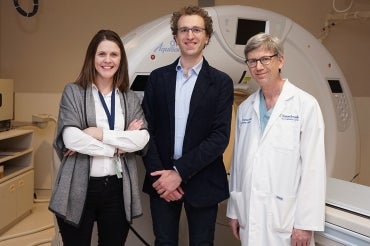U of T experts are using math to mend hearts

Published: February 8, 2018
The heart is complex and mysterious, but a team led by a Faculty of Applied Science & Engineering researcher aims to increase our understanding of it using math.
Coronary artery disease – the buildup of plaque in the heart’s arteries – is the second-leading cause of death in Canada. Physicians will often graft an artery or a vein from elsewhere in the patient’s body to bypass the blocked artery. Unfortunately, the complex behaviour of the cardiovascular system makes it difficult to predict the success rate of a graft – up to 30 per cent fail within a year following surgery.
Now, Piero Triverio, an associate professor in the Edward S. Rogers Sr. department of electrical & computer engineering, is collaborating with physicians and mathematicians to explore how computer simulations can help to identify why grafts fail, and improve treatment procedures.
Currently, surgeons rely on information from CT scans to decide when and how to perform graft surgery, but these anatomical scans include little information on a patient’s unique physiology, such as blood velocity and pressure.
“We want to use the information from traditional medical imaging to set up computational simulations that can provide an unprecedented amount of information on blood flow in individual patients, and relate this information to graft failure,” says Triverio. “This study could help to identify under which scenarios graft surgery is more likely to succeed or fail.”
To do this, Triverio is collaborating with Dr. Stephen Fremes, a cardiothoracic surgeon at Sunnybrook Health Sciences Centre and professor at U of T's Dalla Lana School of Public Health; Dr. Laura Jiménez-Juan, a cardiothoracic radiologist at Sunnybrook Health Sciences Centre and assistant professor of medical imaging at U of T; and Gianluigi Rozza, a professor of numerical analysis and scientific computing at the International School for Advanced Studies (SISSA).
In December 2017, the first patients participating in the study received a CT and MRI scan one month after their graft surgery. The team will combine the anatomy of the patient’s vessels obtained from the medical images with Navier-Stokes equations, which describe the behaviour of fluids, to develop comprehensive simulation models for coronary arteries. One year after surgery, researchers will know whether graft surgery has been successful, and will study the correlation between simulation results and graft failure.
“The complexities of the heart are immense; currently we are able to access only small pieces of information in a very large puzzle,” says Fremes. “If we can develop models that predict how blood flows in the coronary arteries of an individual patient, we can tailor bypass surgery for each patient more accurately – the more information we have, the better decisions we can make for a patient.”



